Disaster Management: Analysis of Hurricane Katrina and Tsunami Impact
VerifiedAdded on 2020/05/04
|8
|1763
|74
Report
AI Summary
This report delves into the critical aspects of disaster management, using Hurricane Katrina, the Sandy Hook shooting, and tsunami events as primary case studies. The introduction provides a harrowing account of Hurricane Katrina's devastation, highlighting the storm's immense impact on New Orleans and the Gulf Coast, including the tragic loss of life and the massive economic toll. The report then examines the Sandy Hook shooting, drawing key conclusions about the importance of school personnel actions, lockdown procedures, and staff training in mitigating such crises. Finally, the report explores the causes and effects of tsunamis, discussing the physics behind their formation and propagation, and emphasizing the crucial role of building location and elevation in minimizing damage. The report concludes with a list of relevant references, providing a foundation for further study on disaster preparedness and response.
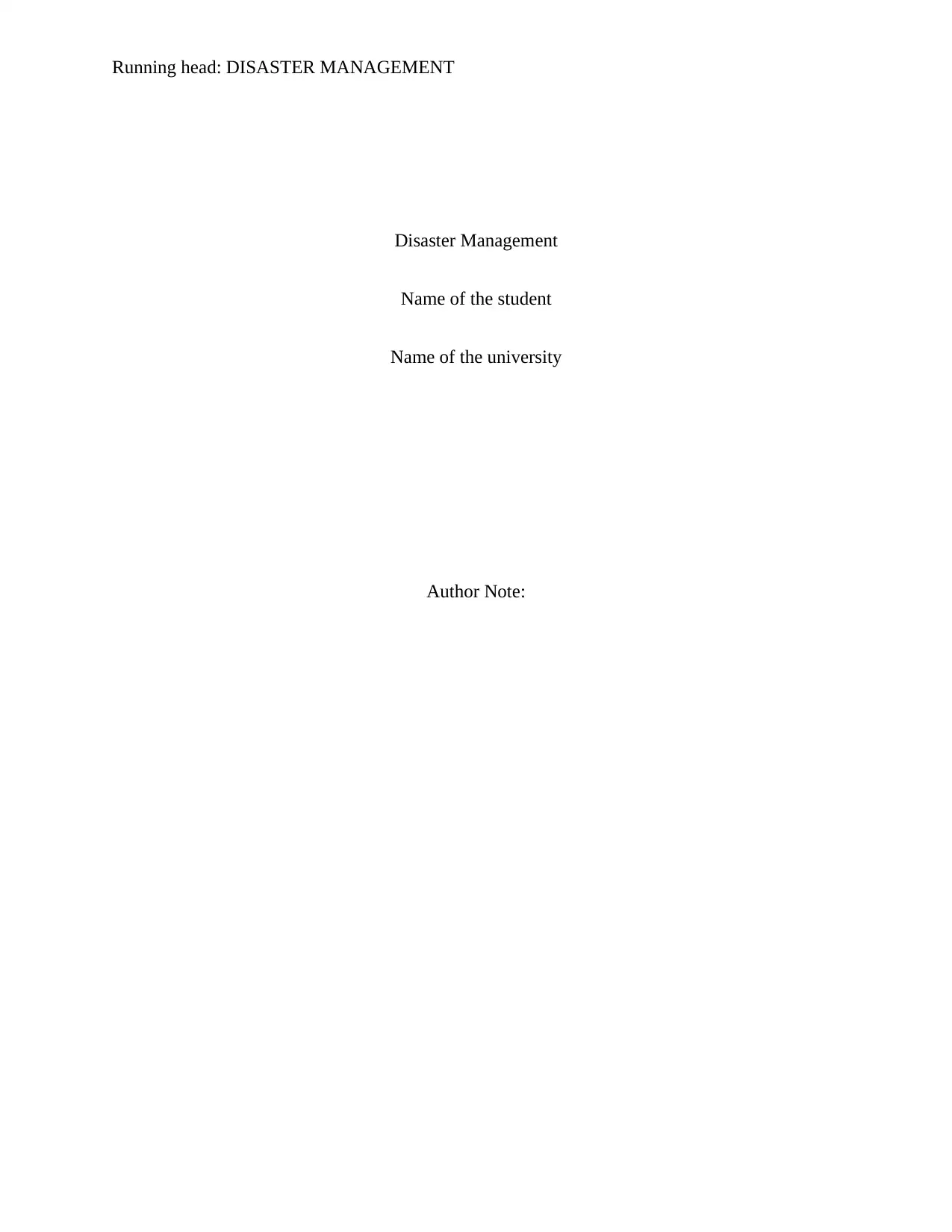
Running head: DISASTER MANAGEMENT
Disaster Management
Name of the student
Name of the university
Author Note:
Disaster Management
Name of the student
Name of the university
Author Note:
Paraphrase This Document
Need a fresh take? Get an instant paraphrase of this document with our AI Paraphraser
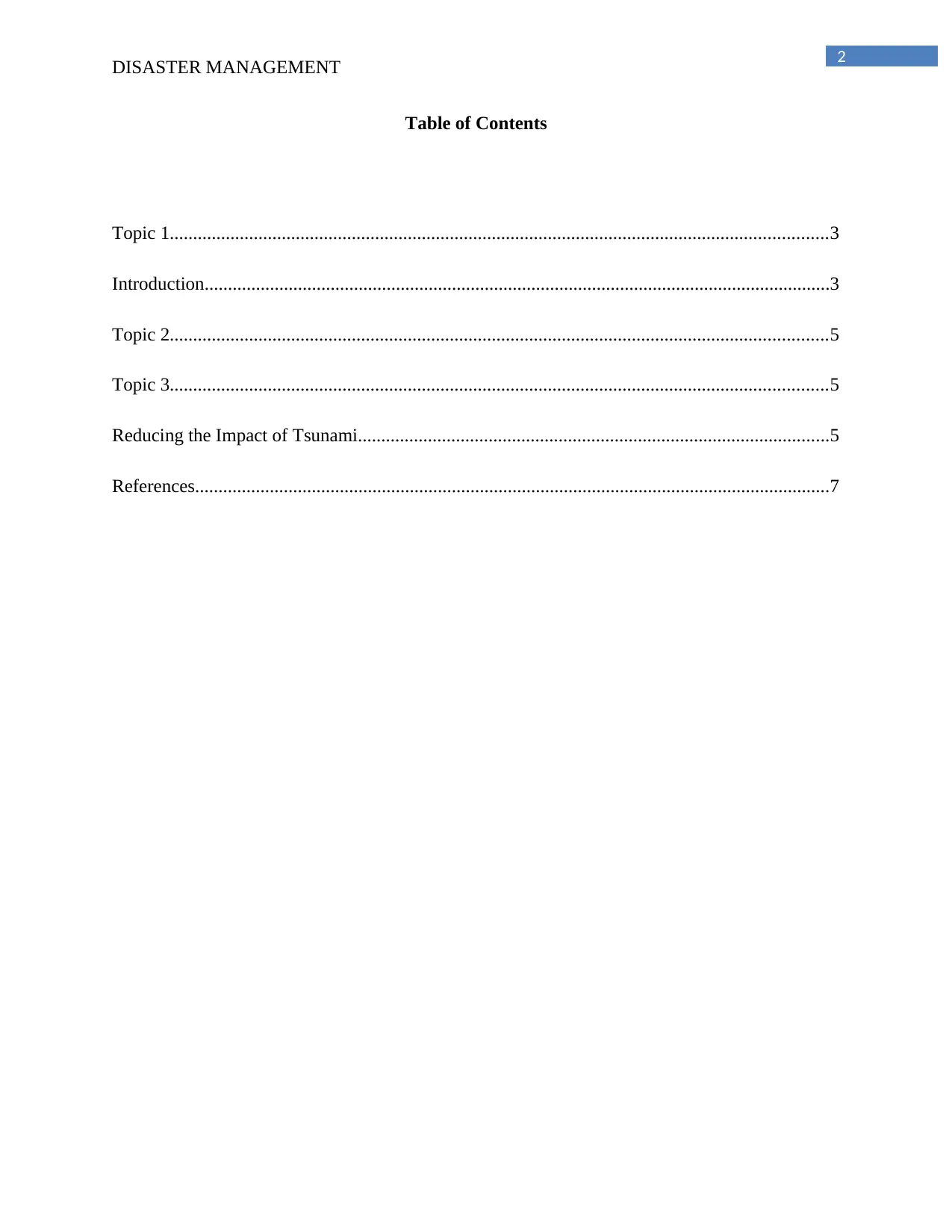
2
DISASTER MANAGEMENT
Table of Contents
Topic 1.............................................................................................................................................3
Introduction......................................................................................................................................3
Topic 2.............................................................................................................................................5
Topic 3.............................................................................................................................................5
Reducing the Impact of Tsunami.....................................................................................................5
References........................................................................................................................................7
DISASTER MANAGEMENT
Table of Contents
Topic 1.............................................................................................................................................3
Introduction......................................................................................................................................3
Topic 2.............................................................................................................................................5
Topic 3.............................................................................................................................................5
Reducing the Impact of Tsunami.....................................................................................................5
References........................................................................................................................................7
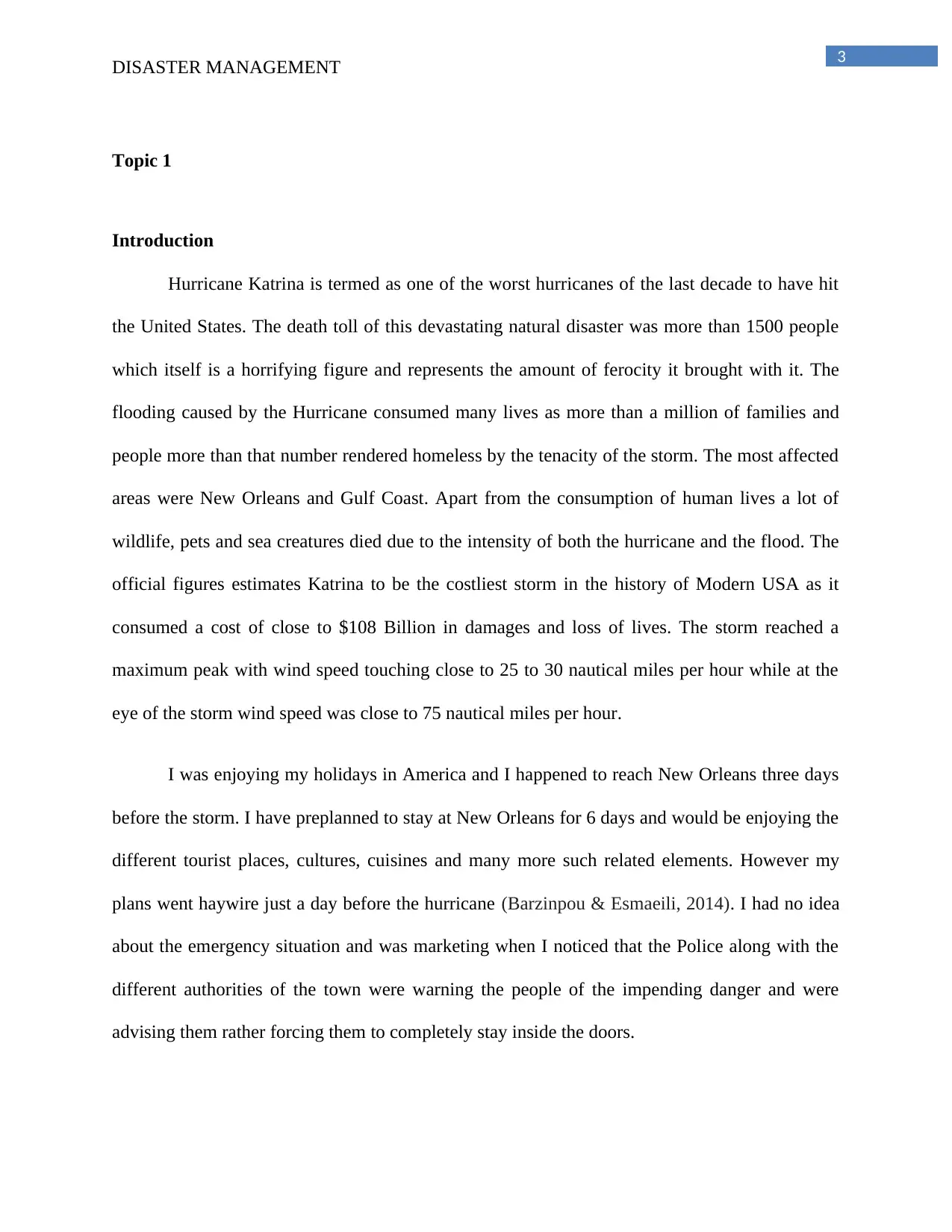
3
DISASTER MANAGEMENT
Topic 1
Introduction
Hurricane Katrina is termed as one of the worst hurricanes of the last decade to have hit
the United States. The death toll of this devastating natural disaster was more than 1500 people
which itself is a horrifying figure and represents the amount of ferocity it brought with it. The
flooding caused by the Hurricane consumed many lives as more than a million of families and
people more than that number rendered homeless by the tenacity of the storm. The most affected
areas were New Orleans and Gulf Coast. Apart from the consumption of human lives a lot of
wildlife, pets and sea creatures died due to the intensity of both the hurricane and the flood. The
official figures estimates Katrina to be the costliest storm in the history of Modern USA as it
consumed a cost of close to $108 Billion in damages and loss of lives. The storm reached a
maximum peak with wind speed touching close to 25 to 30 nautical miles per hour while at the
eye of the storm wind speed was close to 75 nautical miles per hour.
I was enjoying my holidays in America and I happened to reach New Orleans three days
before the storm. I have preplanned to stay at New Orleans for 6 days and would be enjoying the
different tourist places, cultures, cuisines and many more such related elements. However my
plans went haywire just a day before the hurricane (Barzinpou & Esmaeili, 2014). I had no idea
about the emergency situation and was marketing when I noticed that the Police along with the
different authorities of the town were warning the people of the impending danger and were
advising them rather forcing them to completely stay inside the doors.
DISASTER MANAGEMENT
Topic 1
Introduction
Hurricane Katrina is termed as one of the worst hurricanes of the last decade to have hit
the United States. The death toll of this devastating natural disaster was more than 1500 people
which itself is a horrifying figure and represents the amount of ferocity it brought with it. The
flooding caused by the Hurricane consumed many lives as more than a million of families and
people more than that number rendered homeless by the tenacity of the storm. The most affected
areas were New Orleans and Gulf Coast. Apart from the consumption of human lives a lot of
wildlife, pets and sea creatures died due to the intensity of both the hurricane and the flood. The
official figures estimates Katrina to be the costliest storm in the history of Modern USA as it
consumed a cost of close to $108 Billion in damages and loss of lives. The storm reached a
maximum peak with wind speed touching close to 25 to 30 nautical miles per hour while at the
eye of the storm wind speed was close to 75 nautical miles per hour.
I was enjoying my holidays in America and I happened to reach New Orleans three days
before the storm. I have preplanned to stay at New Orleans for 6 days and would be enjoying the
different tourist places, cultures, cuisines and many more such related elements. However my
plans went haywire just a day before the hurricane (Barzinpou & Esmaeili, 2014). I had no idea
about the emergency situation and was marketing when I noticed that the Police along with the
different authorities of the town were warning the people of the impending danger and were
advising them rather forcing them to completely stay inside the doors.
⊘ This is a preview!⊘
Do you want full access?
Subscribe today to unlock all pages.

Trusted by 1+ million students worldwide
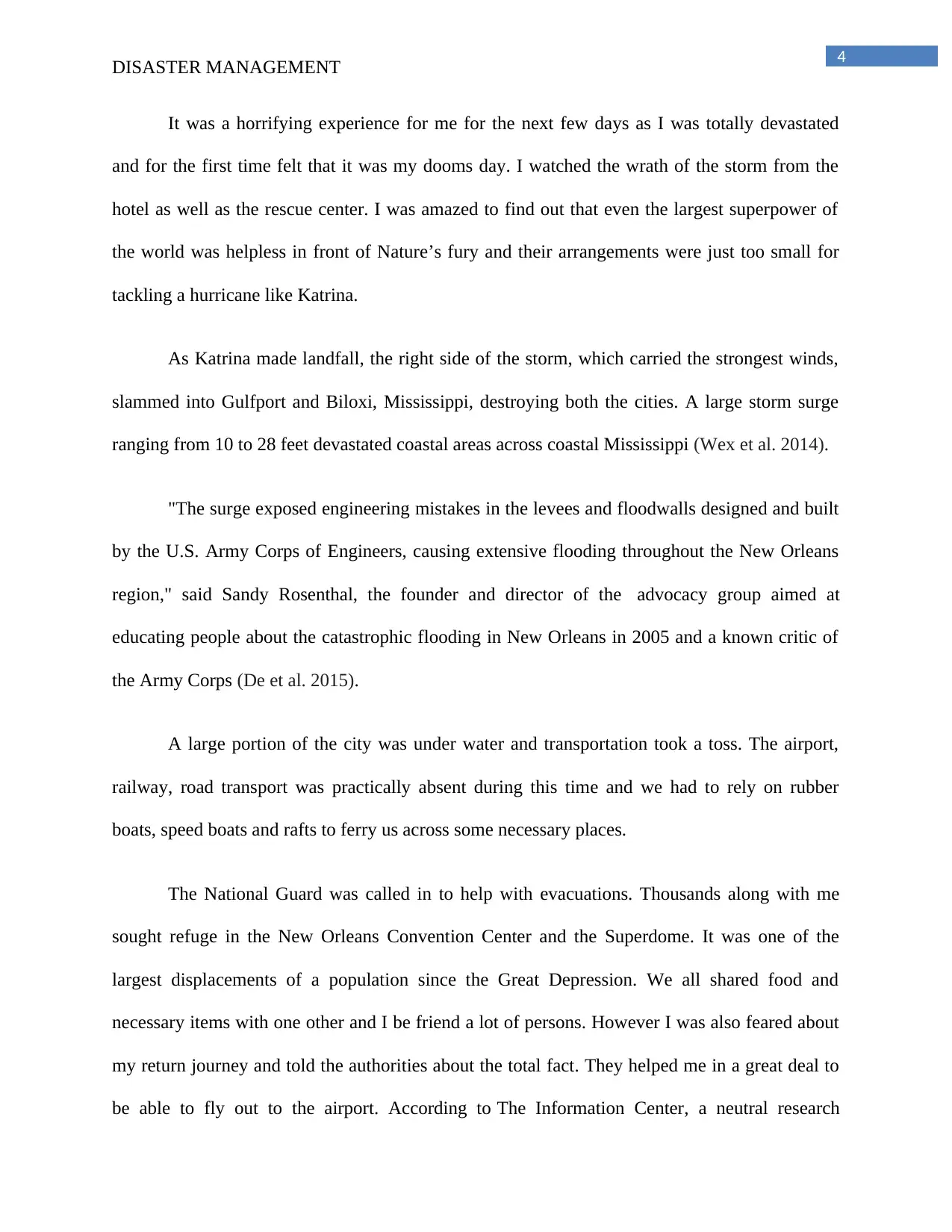
4
DISASTER MANAGEMENT
It was a horrifying experience for me for the next few days as I was totally devastated
and for the first time felt that it was my dooms day. I watched the wrath of the storm from the
hotel as well as the rescue center. I was amazed to find out that even the largest superpower of
the world was helpless in front of Nature’s fury and their arrangements were just too small for
tackling a hurricane like Katrina.
As Katrina made landfall, the right side of the storm, which carried the strongest winds,
slammed into Gulfport and Biloxi, Mississippi, destroying both the cities. A large storm surge
ranging from 10 to 28 feet devastated coastal areas across coastal Mississippi (Wex et al. 2014).
"The surge exposed engineering mistakes in the levees and floodwalls designed and built
by the U.S. Army Corps of Engineers, causing extensive flooding throughout the New Orleans
region," said Sandy Rosenthal, the founder and director of the advocacy group aimed at
educating people about the catastrophic flooding in New Orleans in 2005 and a known critic of
the Army Corps (De et al. 2015).
A large portion of the city was under water and transportation took a toss. The airport,
railway, road transport was practically absent during this time and we had to rely on rubber
boats, speed boats and rafts to ferry us across some necessary places.
The National Guard was called in to help with evacuations. Thousands along with me
sought refuge in the New Orleans Convention Center and the Superdome. It was one of the
largest displacements of a population since the Great Depression. We all shared food and
necessary items with one other and I be friend a lot of persons. However I was also feared about
my return journey and told the authorities about the total fact. They helped me in a great deal to
be able to fly out to the airport. According to The Information Center, a neutral research
DISASTER MANAGEMENT
It was a horrifying experience for me for the next few days as I was totally devastated
and for the first time felt that it was my dooms day. I watched the wrath of the storm from the
hotel as well as the rescue center. I was amazed to find out that even the largest superpower of
the world was helpless in front of Nature’s fury and their arrangements were just too small for
tackling a hurricane like Katrina.
As Katrina made landfall, the right side of the storm, which carried the strongest winds,
slammed into Gulfport and Biloxi, Mississippi, destroying both the cities. A large storm surge
ranging from 10 to 28 feet devastated coastal areas across coastal Mississippi (Wex et al. 2014).
"The surge exposed engineering mistakes in the levees and floodwalls designed and built
by the U.S. Army Corps of Engineers, causing extensive flooding throughout the New Orleans
region," said Sandy Rosenthal, the founder and director of the advocacy group aimed at
educating people about the catastrophic flooding in New Orleans in 2005 and a known critic of
the Army Corps (De et al. 2015).
A large portion of the city was under water and transportation took a toss. The airport,
railway, road transport was practically absent during this time and we had to rely on rubber
boats, speed boats and rafts to ferry us across some necessary places.
The National Guard was called in to help with evacuations. Thousands along with me
sought refuge in the New Orleans Convention Center and the Superdome. It was one of the
largest displacements of a population since the Great Depression. We all shared food and
necessary items with one other and I be friend a lot of persons. However I was also feared about
my return journey and told the authorities about the total fact. They helped me in a great deal to
be able to fly out to the airport. According to The Information Center, a neutral research
Paraphrase This Document
Need a fresh take? Get an instant paraphrase of this document with our AI Paraphraser
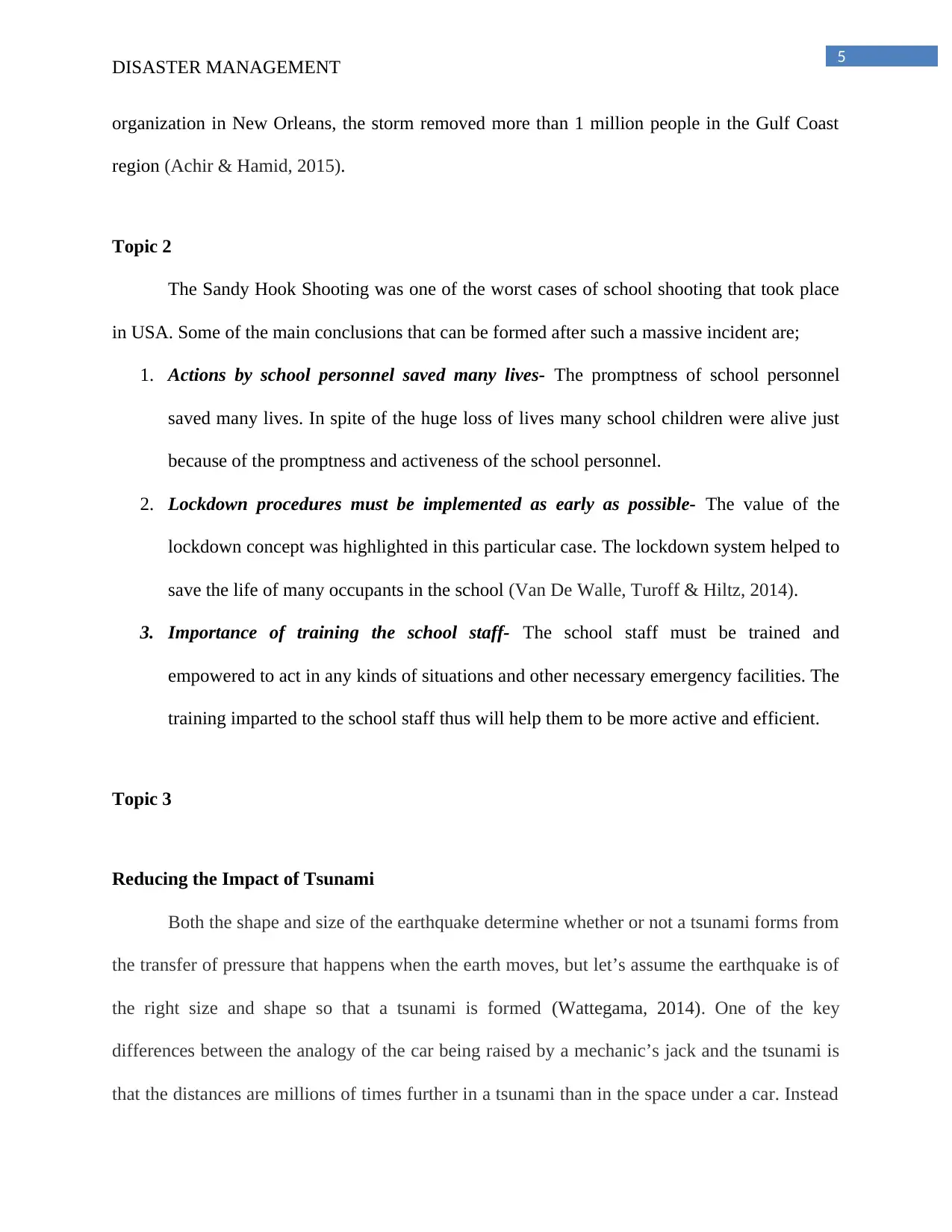
5
DISASTER MANAGEMENT
organization in New Orleans, the storm removed more than 1 million people in the Gulf Coast
region (Achir & Hamid, 2015).
Topic 2
The Sandy Hook Shooting was one of the worst cases of school shooting that took place
in USA. Some of the main conclusions that can be formed after such a massive incident are;
1. Actions by school personnel saved many lives- The promptness of school personnel
saved many lives. In spite of the huge loss of lives many school children were alive just
because of the promptness and activeness of the school personnel.
2. Lockdown procedures must be implemented as early as possible- The value of the
lockdown concept was highlighted in this particular case. The lockdown system helped to
save the life of many occupants in the school (Van De Walle, Turoff & Hiltz, 2014).
3. Importance of training the school staff- The school staff must be trained and
empowered to act in any kinds of situations and other necessary emergency facilities. The
training imparted to the school staff thus will help them to be more active and efficient.
Topic 3
Reducing the Impact of Tsunami
Both the shape and size of the earthquake determine whether or not a tsunami forms from
the transfer of pressure that happens when the earth moves, but let’s assume the earthquake is of
the right size and shape so that a tsunami is formed (Wattegama, 2014). One of the key
differences between the analogy of the car being raised by a mechanic’s jack and the tsunami is
that the distances are millions of times further in a tsunami than in the space under a car. Instead
DISASTER MANAGEMENT
organization in New Orleans, the storm removed more than 1 million people in the Gulf Coast
region (Achir & Hamid, 2015).
Topic 2
The Sandy Hook Shooting was one of the worst cases of school shooting that took place
in USA. Some of the main conclusions that can be formed after such a massive incident are;
1. Actions by school personnel saved many lives- The promptness of school personnel
saved many lives. In spite of the huge loss of lives many school children were alive just
because of the promptness and activeness of the school personnel.
2. Lockdown procedures must be implemented as early as possible- The value of the
lockdown concept was highlighted in this particular case. The lockdown system helped to
save the life of many occupants in the school (Van De Walle, Turoff & Hiltz, 2014).
3. Importance of training the school staff- The school staff must be trained and
empowered to act in any kinds of situations and other necessary emergency facilities. The
training imparted to the school staff thus will help them to be more active and efficient.
Topic 3
Reducing the Impact of Tsunami
Both the shape and size of the earthquake determine whether or not a tsunami forms from
the transfer of pressure that happens when the earth moves, but let’s assume the earthquake is of
the right size and shape so that a tsunami is formed (Wattegama, 2014). One of the key
differences between the analogy of the car being raised by a mechanic’s jack and the tsunami is
that the distances are millions of times further in a tsunami than in the space under a car. Instead
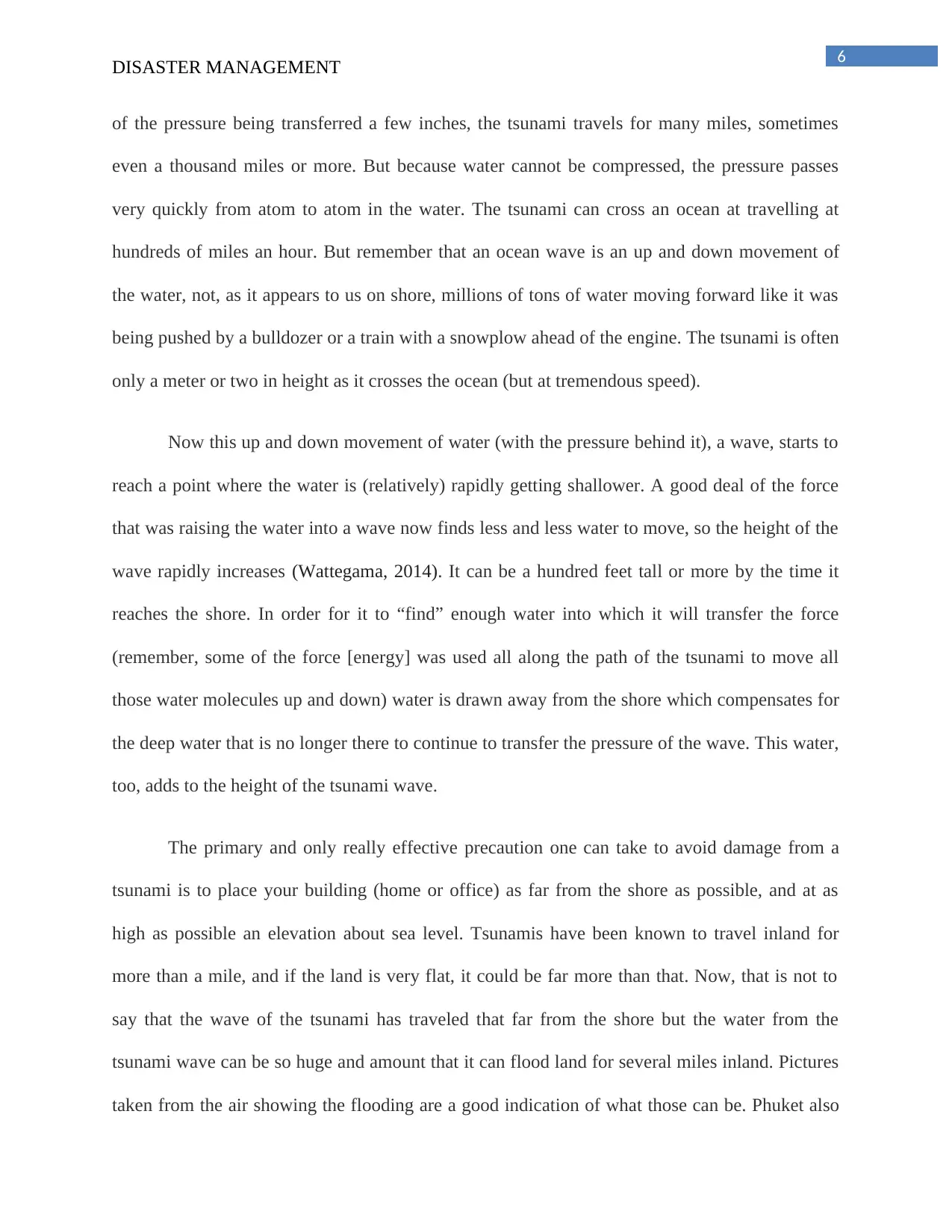
6
DISASTER MANAGEMENT
of the pressure being transferred a few inches, the tsunami travels for many miles, sometimes
even a thousand miles or more. But because water cannot be compressed, the pressure passes
very quickly from atom to atom in the water. The tsunami can cross an ocean at travelling at
hundreds of miles an hour. But remember that an ocean wave is an up and down movement of
the water, not, as it appears to us on shore, millions of tons of water moving forward like it was
being pushed by a bulldozer or a train with a snowplow ahead of the engine. The tsunami is often
only a meter or two in height as it crosses the ocean (but at tremendous speed).
Now this up and down movement of water (with the pressure behind it), a wave, starts to
reach a point where the water is (relatively) rapidly getting shallower. A good deal of the force
that was raising the water into a wave now finds less and less water to move, so the height of the
wave rapidly increases (Wattegama, 2014). It can be a hundred feet tall or more by the time it
reaches the shore. In order for it to “find” enough water into which it will transfer the force
(remember, some of the force [energy] was used all along the path of the tsunami to move all
those water molecules up and down) water is drawn away from the shore which compensates for
the deep water that is no longer there to continue to transfer the pressure of the wave. This water,
too, adds to the height of the tsunami wave.
The primary and only really effective precaution one can take to avoid damage from a
tsunami is to place your building (home or office) as far from the shore as possible, and at as
high as possible an elevation about sea level. Tsunamis have been known to travel inland for
more than a mile, and if the land is very flat, it could be far more than that. Now, that is not to
say that the wave of the tsunami has traveled that far from the shore but the water from the
tsunami wave can be so huge and amount that it can flood land for several miles inland. Pictures
taken from the air showing the flooding are a good indication of what those can be. Phuket also
DISASTER MANAGEMENT
of the pressure being transferred a few inches, the tsunami travels for many miles, sometimes
even a thousand miles or more. But because water cannot be compressed, the pressure passes
very quickly from atom to atom in the water. The tsunami can cross an ocean at travelling at
hundreds of miles an hour. But remember that an ocean wave is an up and down movement of
the water, not, as it appears to us on shore, millions of tons of water moving forward like it was
being pushed by a bulldozer or a train with a snowplow ahead of the engine. The tsunami is often
only a meter or two in height as it crosses the ocean (but at tremendous speed).
Now this up and down movement of water (with the pressure behind it), a wave, starts to
reach a point where the water is (relatively) rapidly getting shallower. A good deal of the force
that was raising the water into a wave now finds less and less water to move, so the height of the
wave rapidly increases (Wattegama, 2014). It can be a hundred feet tall or more by the time it
reaches the shore. In order for it to “find” enough water into which it will transfer the force
(remember, some of the force [energy] was used all along the path of the tsunami to move all
those water molecules up and down) water is drawn away from the shore which compensates for
the deep water that is no longer there to continue to transfer the pressure of the wave. This water,
too, adds to the height of the tsunami wave.
The primary and only really effective precaution one can take to avoid damage from a
tsunami is to place your building (home or office) as far from the shore as possible, and at as
high as possible an elevation about sea level. Tsunamis have been known to travel inland for
more than a mile, and if the land is very flat, it could be far more than that. Now, that is not to
say that the wave of the tsunami has traveled that far from the shore but the water from the
tsunami wave can be so huge and amount that it can flood land for several miles inland. Pictures
taken from the air showing the flooding are a good indication of what those can be. Phuket also
⊘ This is a preview!⊘
Do you want full access?
Subscribe today to unlock all pages.

Trusted by 1+ million students worldwide
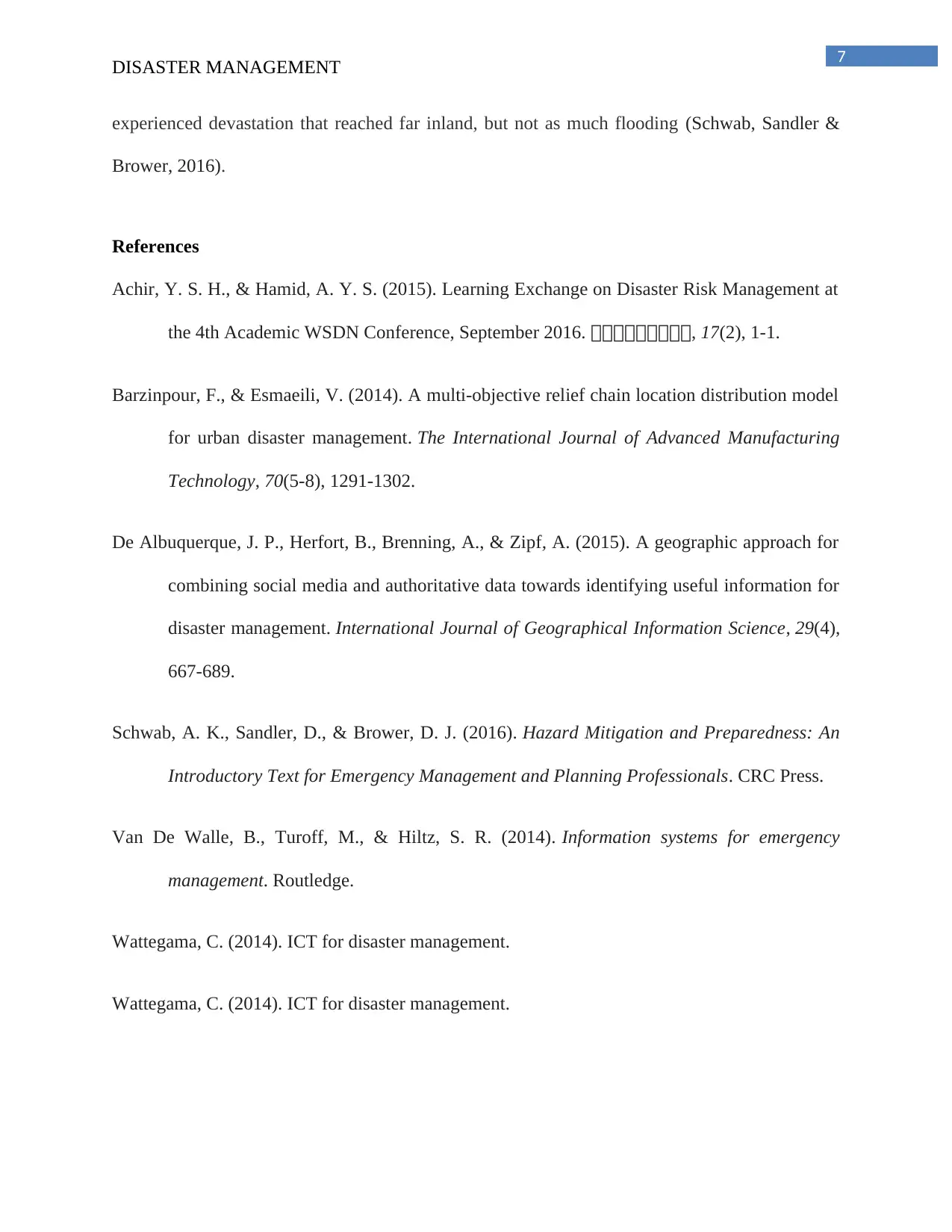
7
DISASTER MANAGEMENT
experienced devastation that reached far inland, but not as much flooding (Schwab, Sandler &
Brower, 2016).
References
Achir, Y. S. H., & Hamid, A. Y. S. (2015). Learning Exchange on Disaster Risk Management at
the 4th Academic WSDN Conference, September 2016. 日日日日日日日日日, 17(2), 1-1.
Barzinpour, F., & Esmaeili, V. (2014). A multi-objective relief chain location distribution model
for urban disaster management. The International Journal of Advanced Manufacturing
Technology, 70(5-8), 1291-1302.
De Albuquerque, J. P., Herfort, B., Brenning, A., & Zipf, A. (2015). A geographic approach for
combining social media and authoritative data towards identifying useful information for
disaster management. International Journal of Geographical Information Science, 29(4),
667-689.
Schwab, A. K., Sandler, D., & Brower, D. J. (2016). Hazard Mitigation and Preparedness: An
Introductory Text for Emergency Management and Planning Professionals. CRC Press.
Van De Walle, B., Turoff, M., & Hiltz, S. R. (2014). Information systems for emergency
management. Routledge.
Wattegama, C. (2014). ICT for disaster management.
Wattegama, C. (2014). ICT for disaster management.
DISASTER MANAGEMENT
experienced devastation that reached far inland, but not as much flooding (Schwab, Sandler &
Brower, 2016).
References
Achir, Y. S. H., & Hamid, A. Y. S. (2015). Learning Exchange on Disaster Risk Management at
the 4th Academic WSDN Conference, September 2016. 日日日日日日日日日, 17(2), 1-1.
Barzinpour, F., & Esmaeili, V. (2014). A multi-objective relief chain location distribution model
for urban disaster management. The International Journal of Advanced Manufacturing
Technology, 70(5-8), 1291-1302.
De Albuquerque, J. P., Herfort, B., Brenning, A., & Zipf, A. (2015). A geographic approach for
combining social media and authoritative data towards identifying useful information for
disaster management. International Journal of Geographical Information Science, 29(4),
667-689.
Schwab, A. K., Sandler, D., & Brower, D. J. (2016). Hazard Mitigation and Preparedness: An
Introductory Text for Emergency Management and Planning Professionals. CRC Press.
Van De Walle, B., Turoff, M., & Hiltz, S. R. (2014). Information systems for emergency
management. Routledge.
Wattegama, C. (2014). ICT for disaster management.
Wattegama, C. (2014). ICT for disaster management.
Paraphrase This Document
Need a fresh take? Get an instant paraphrase of this document with our AI Paraphraser
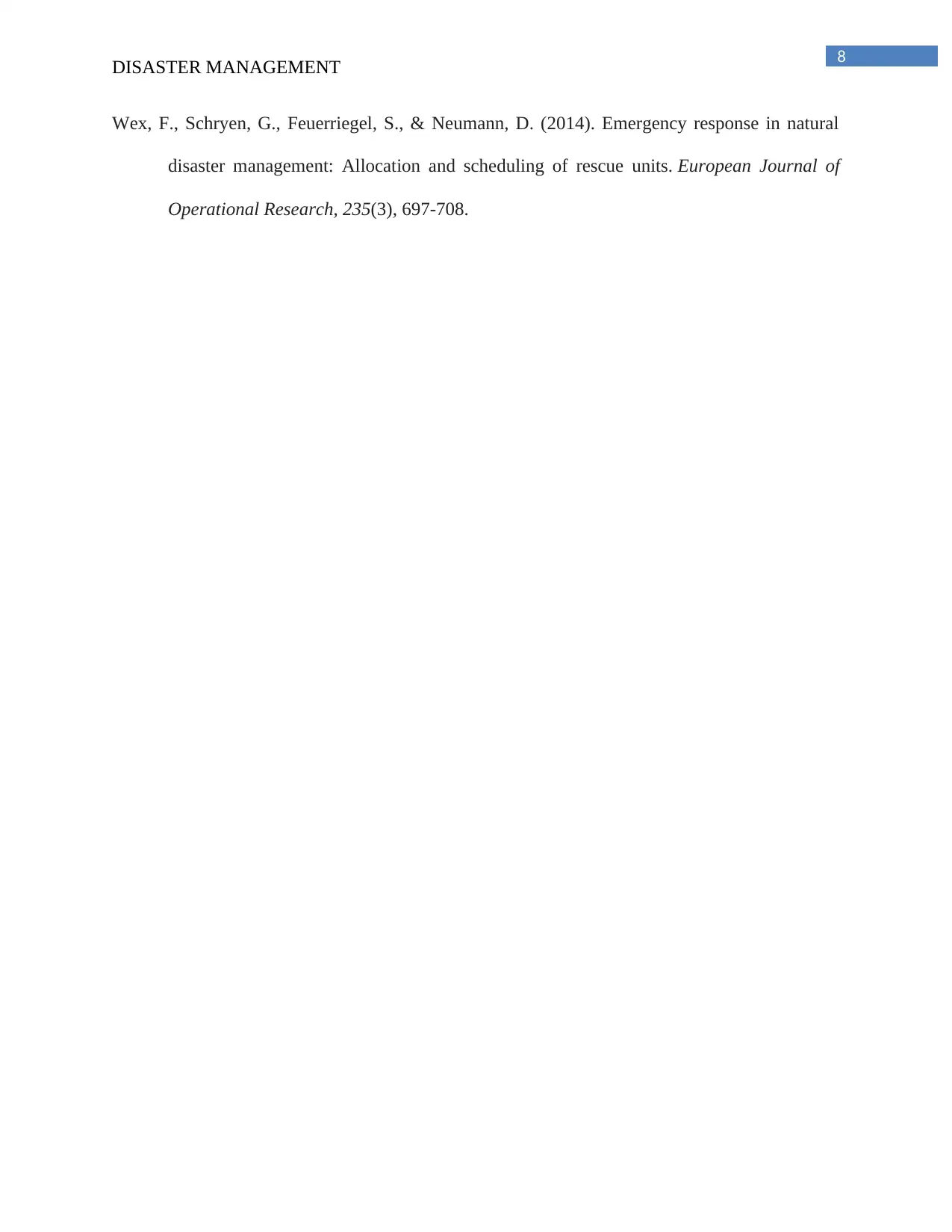
8
DISASTER MANAGEMENT
Wex, F., Schryen, G., Feuerriegel, S., & Neumann, D. (2014). Emergency response in natural
disaster management: Allocation and scheduling of rescue units. European Journal of
Operational Research, 235(3), 697-708.
DISASTER MANAGEMENT
Wex, F., Schryen, G., Feuerriegel, S., & Neumann, D. (2014). Emergency response in natural
disaster management: Allocation and scheduling of rescue units. European Journal of
Operational Research, 235(3), 697-708.
1 out of 8
Related Documents
Your All-in-One AI-Powered Toolkit for Academic Success.
+13062052269
info@desklib.com
Available 24*7 on WhatsApp / Email
![[object Object]](/_next/static/media/star-bottom.7253800d.svg)
Unlock your academic potential
Copyright © 2020–2025 A2Z Services. All Rights Reserved. Developed and managed by ZUCOL.





